By Harold C. Ford
In its third year of operation, Flint’s newest school, the nonprofit charter Flint Cultural Center Academy (FCCA), has managed to survive and continue adding grades despite adjustments to COVID, construction at the nearby Sloan Museum and Flint Public Library, and challenges faced by some of its economically-disadvantaged students.
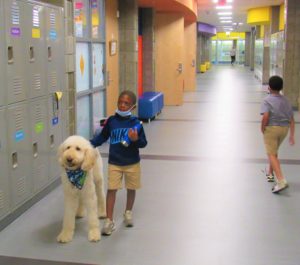
FCCA student walking with a “comfort” dog between classes. (Photo by Harold Ford)
“We’re not where we thought we’d be after two full years of school,” said Eric Lieske, FCCA principal, in a recent wide-ranging interview with East Village Magazine (EVM). “Nobody knew that we were going to be in a global health pandemic.”
This year, with a staff of 55, the school has 525 students up to and including grade seven, all from Genesee County; 82 percent are from Flint. Of those, according to the MI School Data website, ,in 2020-21, 82 percent were “economically disadvantaged (2020-21) and 7.8 percent were “students with disabilities.” The website reports a 22 to 1 teacher to student ratio.
The SchoolDigger website reports 66.3 percent of FCCA students are African American, 16 percent white, and 13.6 percent “two or more races.”
When it opened to students in August, 2019, according to its website, the school enrolled more than 300 students in kindergarten through fifth grade. The second year, grade six was added as the original fifth graders advanced, and this year, seventh grade came in, with grade eight expected to be added next year.
At that point, the school will have fulfilled its initial K-8 design, with a hoped-for yearly enrollment of 650 students.
Lieske said plans are being made to keep FCCA 7th graders at FCCA when they matriculate into the 8th grade. EVM asked where the FCCA 8th graders would go thereafter.
“We’re working on that,” Lieske replied. “We have some plans that we’re working on. We certainly want to be able to provide a continuum of learning in a secondary setting.”
The 78,000-square-foot campus contains 37 classrooms, a gymnasium, cafeteria, and kitchen. Direct access to the Flint Institute of Music and Sloan Museum is provided via an adjacent exhibit and learning space that features three multipurpose classrooms.
Currently, 23 of FCCA’s classrooms are in use, according to Lieske.

One of FCCA’s 37 classrooms. (Photo by Harold Ford)
And as for how its students are doing so far, though Lieske says it’s “a terrible time to talk about standardized testing” during COVID challenges, recent test data indicates that FCCA students performed better than students in Flint Community Schools but not as well as other students in Genesee County (see further detail below).
“The data doesn’t always tell the true story,” Lieske warned. “We have to dig deeper about how we compare kids.”
Lieske said he is about “changing the dynamics of what an inner-city school can look like … The number one thing we can do with children is build amazing relationships. That’s very, very challenging to do in the virtual setting.”
Lieske said he wants kids who come to FCCA to know that “they’re loved, there’s trust built, that this is a positive place for them … Then we can look at how we’re going to make economic, emotional, and social growth.”
Lieske drawn from Davison to FCCA
The opportunity to become FCCA’s first principal drew Lieske from Davison where he was born and raised. His parents owned a hardware store on the main street of Davison. He graduated from Davison High School in 1989.
After graduating from the University of Michigan-Flint (B.A.) and Marygrove College (M.A., Curriculum Instruction) he obtained an education specialist degree from the UM-Flint.
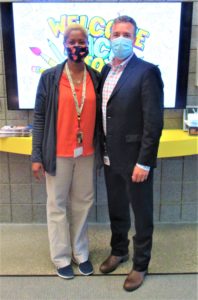
CEO Lieske stands with FCCA Social Worker Gabrielle Holmes-Scott. (Photo by Harold Ford)
A long career with Davison Community Schools included stints as an elementary school teacher, assistant principal, principal, assistant superintendent, and superintendent. “I was very happy at Davison,” he said.
Talks with the C.S. Mott Foundation about Davison-based projects such as the balanced calendar “turned into a conversation about who’s going to lead this school (FCCA),” recalled Lieske. “Maybe that was a fit for me.”
And he asserts he was lured to the FCCA principalship by the opportunity to make something brand new. “Nobody gets to build a school from the ground up,” he said. “All new teachers, all new kids, all new curriculum.”
Four years from conception to school opening
The idea for the school first emerged in 2015, according to Mark Sinila, chief operating officer of the FCC Corporation which helps to coordinate the school. The Flint-based C. S. Mott Foundation provided $2.9 million for the school’s planning and development. Flint-based THA Architects Engineers and E & L Construction Group, Inc. became the project’s design and construction partners.
At the groundbreaking for FCCA on June 26, 2018, the Mott Foundation announced its commitment of $35 million “to cover the costs of designing, constructing, and outfitting the school, as well as making related improvements to the Cultural Center campus.”
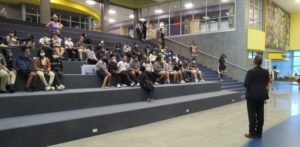
“They’ve [Mott Foundation] been very generous with start-up construction, curriculum, furniture, and things like that,” Lieske said.
In a forthright review of the school’s circumstances, Lieske detailed advantages enjoyed by the FCCA and disadvantages it has combatted since its inception.
FCCA Advantages
The most obvious advantage of FCCA is its location in the heart of the Flint Cultural Center that includes the Flint Public Library, Sloan Museum, Whiting Auditorium, Longway Planetarium, the Flint Institute of Music, Flint Repertory Theater, the Flint Institute of Arts, Applewood Estate, and the Flint Institute of Music (FIM).
FCCA students have direct access to the FIM and Sloan without even going outdoors. All other institutions are located within a block of the FCCA campus.
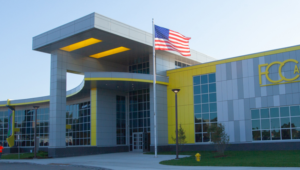
FCCA’s main entrance facing Robert T. Longway. (Photo source FCCA website)
“The location is amazing,” Lieske declared. “There’s not another city in the nation with less than 100,000 population that has the amenities of the Flint Cultural Center campus. Being able to be tied to these institutions is second to none.”
FCCA leadership endeavors to have students spend 90 minutes at FCC institutions every school day.
Also, FCCA is a modern, state-of-the-art campus featuring interesting architectural design, cheerful colors, and plentiful windows that permit daylight and sunshine to bathe the hallways and common meeting areas.
Classrooms are interconnected by flexible walls that can provide for individual class sessions or larger multi-class meetings. Terraced meeting areas called Learning Stairs are also utilized for larger group sessions.
Every student is provided an electronic learning device. The dress code offers students a choice of five basic colors.
FCCA disadvantages
Transportation for FCCA students is a challenge. “We don’t have busing,” said Lieske. Parents must provide transportation. The FCCA parking lot is small and traffic congestion is nearly a daily occurrence.
Lieske also named unfinished construction at Sloan Museum and the Flint Public Library (FPL) as additional challenges. Until renovations are completed, Sloan and FPL educators travel to the FCCA campus. “But we want to get our kids on the campuses of those places,” Lieske said.
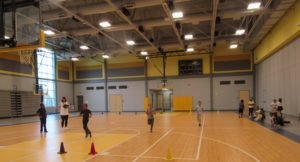
Students in the FCCA gymnasium. (Photo by Harold Ford)
These are important elements for the FCCA. The MI School Data website reported that 82 percent of FCCA students are “economically disadvantaged” (2020-21) and 7.8 percent are “students with disabilities.”
The entirety of the FCCA student population qualifies for free and reduced lunches. (The free and reduced lunch formula provides that when a certain percentage of a student population qualifies for free and reduced, then all qualify.)
The pandemic
Nothing, however, challenged the newest school in Flint more than the COVID-19 pandemic, according to Lieske.
“It’s been challenging with COVID for a new start-up school,” Lieske said. “School is not the same when it’s virtual. Things started to gel and then we went into that (state) mandated shutdown.”
Test data
Recent test data indicates that FCCA students performed better than students in Flint Community Schools but not as well as other students in Genesee County or the state except for, perhaps, “students with similar characteristics.” The data reported is from the 2020-21 M-STEP, Michigan Student Test of Educational Progress. (Note: the test data reported is not always uniform, reported in the same way.)
FCCA:
- Percent proficient in Math (grades 3, 4, 5, 6): five to fifteen percent
- Percent proficient in English Language Arts (grades 3, 4, 5, 6): twenty to thirty percent
- Percent proficient in Science (grade 5): five percent
- Percent proficient in Social Studies (grade 5): five percent
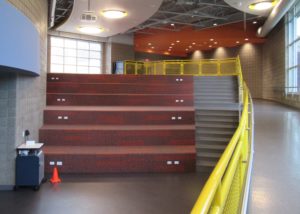
FCS, percent proficient in all subject areas:
- Brownell STEM Academy (grades K-5): no data available
- Doyle/Ryder (grades K-6): less than five percent
- Durant Tuuri Mott (grades K-6): less than five percent
- Eisenhower (grades K-6): less than five percent
- Freeman (grades K-6): seven percent
- Neithercut (grades K-6): less than five percent
- Pierce (grades K-6): less than five percent
- Potter (grades K-6): less than five percent
Genesee County
- Students proficient in English Language Arts (grade 3): 36.9 percent
- Students proficient in Math and English (grades 3-8): 24.4 percent
Michigan
- Elementary students testing proficient in all subjects: 37 percent
- “Similar Schools (to FCCA) by Student Characteristics” testing proficient in all subjects: 12 percent
Authorizing agency is Grand Valley State
As a non-profit public charter school, the FCCA is open to all students in Michigan. Initial enrollment was via a lottery system. Lieske told EVM in March 2019: “We’ve had interest from as far north as Mt. Pleasant down to Clarkston.
Nonetheless, as Lieske noted in the September interview, this year all of FCCA’s 525 students are from Genesee County; 82 percent are from Flint.
Flint resident and State Senate Minority Leader Jim Ananich told EVM at the June 2018 groundbreaking that Flint Community Schools, under the leadership of then-Superintendent Bilal Tawwab, turned down the opportunity to charter the school.
“I talked to the superintendent (Tawwab) and they weren’t interested in it,” said Ananich. He (Tawwab) said capacity-wise they couldn’t handle it.”
Grand Valley State University, headquartered in Grand Rapids, subsequently became the authorizing agency for FCCA.
“It’s a mistake on the part of the Flint schools,” Ananich said at the time.
Realism and optimism
Lieske is realistic and optimistic about the future for FCCA and its students. “We have a lot of work yet to do,” he said. “I believe the trajectory of this school is just getting ready to go.”
EVM Education Beat reporter Harold C. Ford can be reached at hcford1185@gmail.com.


You must be logged in to post a comment.